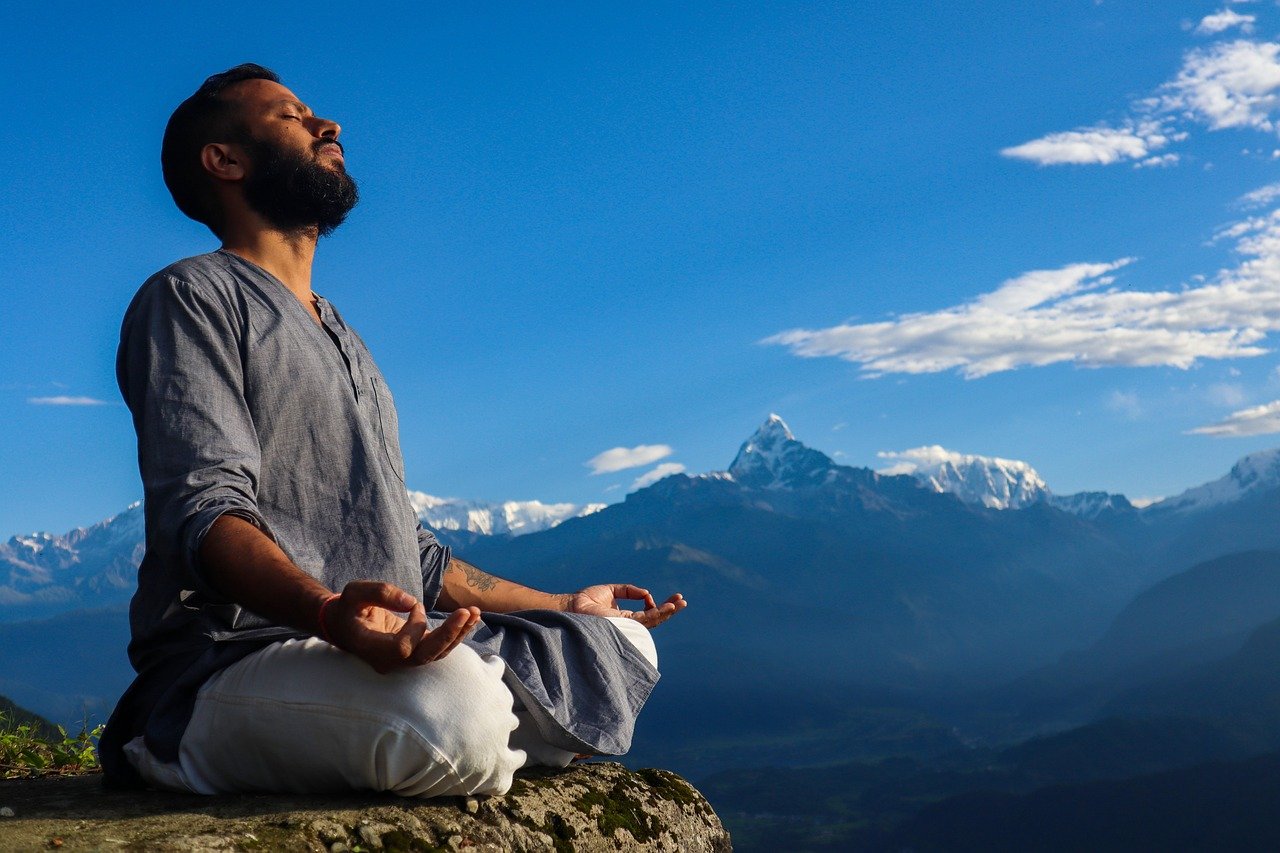According to the studies, practicing yoga can help reduce people’s stress, anxiety, and depression. It may be better than traditional medication if you follow it daily for over a month. Yoga is also an effective way to help people overcome addictions.
Each day yoga practice will build up more confidence, happiness, and security within yourself to take your life to the next level, take things into your own hands, and create a better life for yourself.
In this article, we will check the origins of yoga, its benefits, and some tips to get you started which will make this article more interesting.
Origin and History of Yoga
Yoga is a practice that originated in India over 5,000 years ago and is a combination of physical poses, breathing techniques, and meditation. The word “yoga” comes from the Sanskrit word “yuj” which means to join or unite.
It is believed to have been developed by ancient Indian sages as a way to attain spiritual enlightenment; this can be found in many Indian scriptures. It has been adapted and accepted over the years, and there are now many different styles of yoga, each with different focuses and practices.
Benefits of Yoga
Yoga has numerous physical and mental benefits, including:
Physical benefits of yoga
- Increased flexibility: Yoga’s practice of stretching and bending can help improve flexibility, increase range of motion and mobility.
- Improved strength: Yoga is a full-body workout that strengthens and tones muscles, especially core strength. It also helps in balancing muscles, which increases endurance and reduces the risk of injury.
- Better posture: The practice of yoga encourages individuals to maintain good posture as they move. Constantly maintaining correct posture improves muscle strength and increases self-awareness.
- Increased energy levels: Yoga helps increase energy levels by promoting circulation and stimulating the body’s natural energy levels.

Mental benefits of yoga
- Reduced stress and anxiety: Yoga’s focus on calm breathing, fluid movements, and deep relaxation can help reduce stress and anxiety levels.
- Improved mental clarity and focus: Yoga focuses on keeping the mind present, allowing you to let go of distractions and focus more on your practice.
- Increased self-awareness: Yoga’s practices promote self-reflection and awareness, helping you to be more attuned to your body, thoughts, and feelings.
Types of Yoga
There are many different styles of yoga, each with a different focus and technique. Here are some of the most popular types of yoga:
- Hatha yoga: A slower-paced, beginner-friendly style of yoga that focuses on breathing and basic positions.
- Vinyasa yoga: A more dynamic style of yoga that focuses on the flow between positions.
- Ashtanga yoga: A challenging and advanced form of yoga, incorporating faster-paced movements and demanding poses.
- Iyengar yoga: This type of yoga is geared towards precise postures and alignment, making use of props such as yoga blocks and straps.
- Bikram yoga: This highly structured practice requires participants to perform a series of 26 poses over 90 minutes while in a heated studio.
- Restorative yoga: A slower-paced style of yoga that focuses on relaxation and rejuvenation.
Getting Started with Yoga
Getting started with yoga can seem daunting, but it doesn’t have to be. Here are some tips to get you started:
- Finding a teacher or class: Look for teachers who are certified and have experience in teaching beginners.
- What to wear and bring to class: Wear comfortable clothing and bring a yoga mat and a water bottle.
- How often to practice: Aim to practice yoga at least twice a week.
Yoga Poses (Asanas)
Yoga poses, or asanas, are the physical positions that are held during a yoga practice. Here are some of the most common poses:
- Downward-Facing Dog: This pose targets the whole body, stretching out the arms, legs, and muscles through the back.
- Warrior pose 2: This pose strengthens the legs and tones the abdominal muscles.
- Tree Pose: This pose helps improve balance and strengthens the legs and core.
- Child’s Pose: This is a restful pose that releases tension in the back and neck.
- Sun Salutation: This sequence is a great warm-up, targeting the whole body and incorporating breathing techniques.
Breathing Techniques (Pranayama)
Breathing techniques are an integral part of yoga practice. Here are some common breathing techniques used in yoga:
- Ujjayi breath: This deep, hissing, or oceanic breathing technique is used to help regulate the breath and calm the mind.
- Kapalbhati breath: This is a powerful, active breathing technique that can help stimulate the digestive system and improve blood flow.
- Nadi Shodhana breath: Also known as alternate nostril breathing, this technique helps balance the left and right sides of the brain.
Meditation & Mindfulness Practices
Meditation and mindfulness practices are important elements of yoga and offer a range of benefits, including:
- Reduced stress and anxiety
- Improved concentration and overall cognitive function
- Increased self-awareness and mindfulness in daily life
Yoga for Specific Health Conditions
Yoga can be helpful for managing certain health conditions, including:
- Stress and anxiety: Yoga can help reduce stress and anxiety levels.
- Back pain: Yoga can help improve flexibility, strength, and posture, which can reduce back pain.
- Arthritis: Yoga can help reduce pain and stiffness associated with arthritis.
- Pregnancy: Prenatal yoga can help prepare the body for childbirth and relieve common pregnancy symptoms.
Ayurveda and Yoga
Ayurveda is a traditional Indian medical system that focuses on maintaining balance in the body through the use of natural remedies and lifestyle practices. Here we discuss how Ayurveda and yoga are related:
- Relationship between Ayurveda and yoga: Both Ayurveda and yoga originated in India and share many principles and practices.
- Ayurvedic principles and how they relate to yoga: Ayurveda focuses on balancing the three doshas, or energies in the body, while yoga helps balance the mind, body, and spirit.
The Philosophy of Yoga
The philosophy of yoga centers around the eight limbs of yoga, each designed to support and guide a yoga practitioner on their spiritual journey:
- Yamas: ethical principles, including non-violence, honesty, and non-stealing
- Niyamas: personal observances, including cleanliness, contentment, and self-study
- Asanas: physical postures
- Pranayama: breath control
- Pratyahara: sensory withdrawal
- Dharana: concentration
- Dhyana: meditation
- Samadhi: union with the divine
Yoga and Nutrition
A healthy diet is a vital part of a yoga practice. Here are some tips for maintaining a healthy diet while practicing yoga:
- Importance of a healthy diet for yoga practice: Eating nourishing foods is essential for supporting physical and mental health.
- Nutrients to support your yoga practice: Eat nutrient-dense foods, such as whole grains, fruits, and vegetables, that provide energy and support muscle recovery.
- Ayurvedic diet principles: According to Ayurveda, certain foods can be beneficial in promoting balance within the body.
Yoga Props
Yoga props, such as blocks, straps, and bolsters, help make certain poses more accessible and can help deepen stretches. Here’s what you need to know:
Common props used in yoga:
- Yoga blocks: These blocks provide support, stability, and can be used to modify poses for different body types.
- Yoga straps: These straps can help extend reach, support joints, and facilitate deeper stretches.
- Bolsters: These are firm cushions used to promote relaxation and support certain poses.
- How to choose and use yoga props: Certain props work better for different body types and yoga styles.
Advanced Yoga Practices
For those ready to take their yoga practice to the next level, there are more advanced techniques to incorporate:
- Advanced asanas and sequences: These advanced practices require more strength, flexibility, and focus.
- Pranayama techniques for advanced practitioners: These techniques challenge and refine breath control.
- Meditation and mindfulness for advanced practitioners: These help refine and deepen a practitioner’s meditative practice.
Yoga for Children and Schools
Yoga offers numerous benefits for children and can be integrated into school curriculums. Here are some benefits:
- Benefits of yoga for children: Yoga helps improve flexibility, focus, mental clarity, and overall well-being.
- Integrating yoga into schools and education: Many schools offer yoga classes and integrate it into their curriculums.
Yoga Retreats & Training Programs
Yoga retreats and training programs are a great way to deepen your practice and connect with other yoga practitioners.
- Finding a yoga retreat or training program: Many yoga studios and retreat centers offer retreats and training programs.
- Choosing the right program for you: There are programs available for beginners, intermediate, and advanced level practitioners.
Common Misconceptions about Yoga
There are many myths and misconceptions surrounding yoga. Here are some common ones:
- Yoga is only for flexible people: Yoga can be practiced by anyone, regardless of their level of flexibility.
- Yoga is a religion: Yoga is a philosophy and lifestyle, but not a religion.
- Yoga is not a workout: Yoga is a whole-body workout that promotes strength, flexibility, and balance.
FAQs
- What should I wear to a yoga class?
- Wear comfortable clothes that allow you to move freely.
- How often should I practice yoga?
- At least twice a week.
- Can I do yoga at home?
- Yes, many online resources and apps offer yoga classes you can do at home.
- Can yoga help with weight loss?
- Yes, yoga can help with weight loss through increased metabolism, and stress reduction.
- Is yoga safe for everyone?
- While yoga is generally safe for most people, it is important for individuals to speak to their doctor or healthcare practitioner before starting a practice.
Conclusion
Yoga is an ancient practice that offers numerous physical, mental, and spiritual benefits. Whether you are a beginner or an advanced practitioner, there is a style of yoga and a practice that can meet your needs and help guide you on your journey to greater well-being. Incorporate yoga into your daily routine and enjoy the many benefits it offers.



